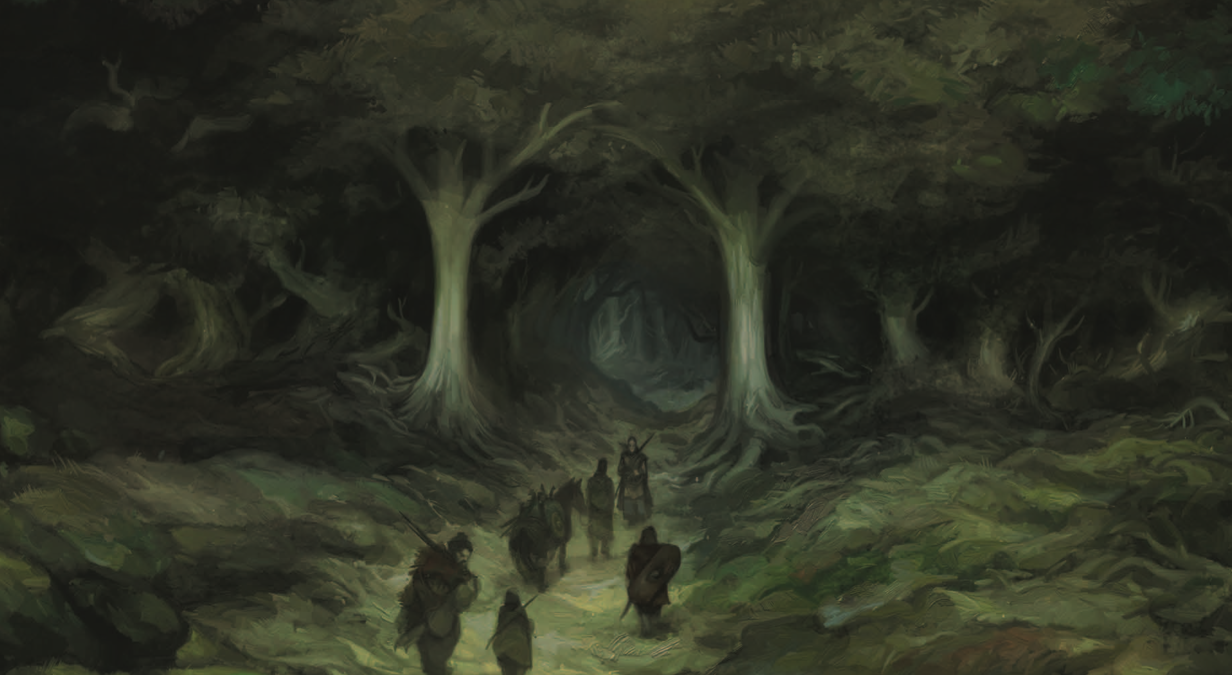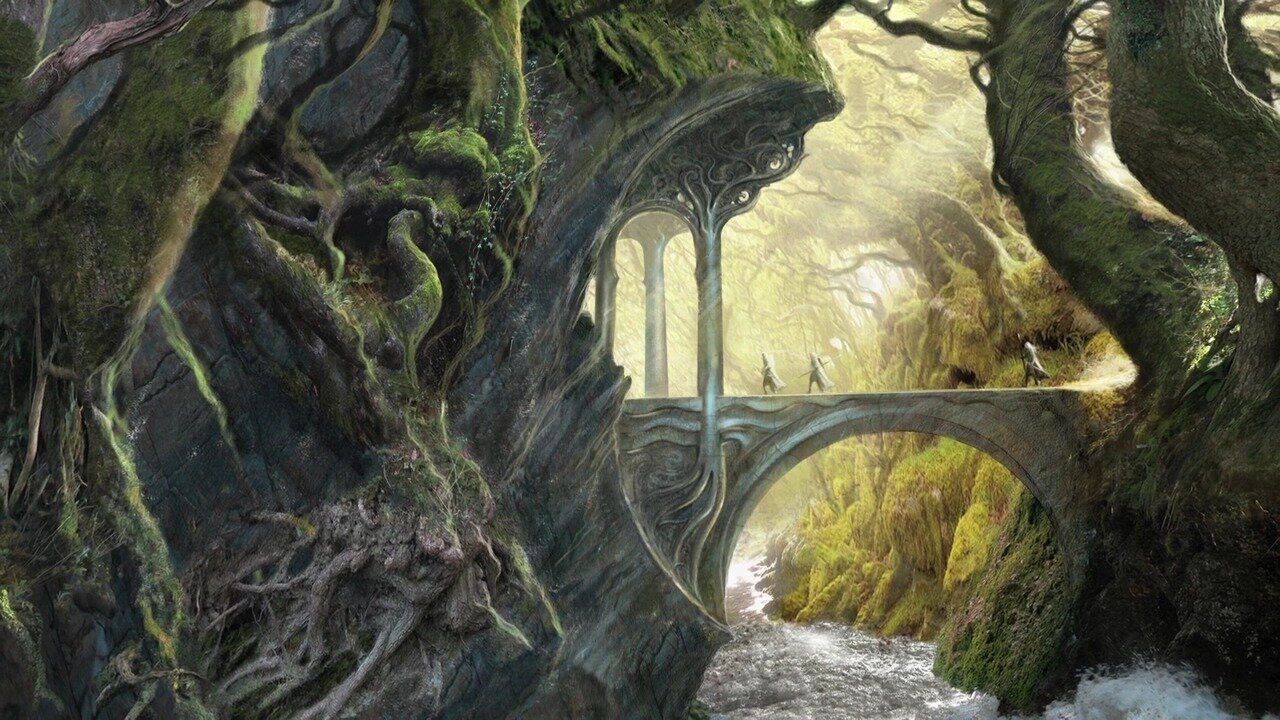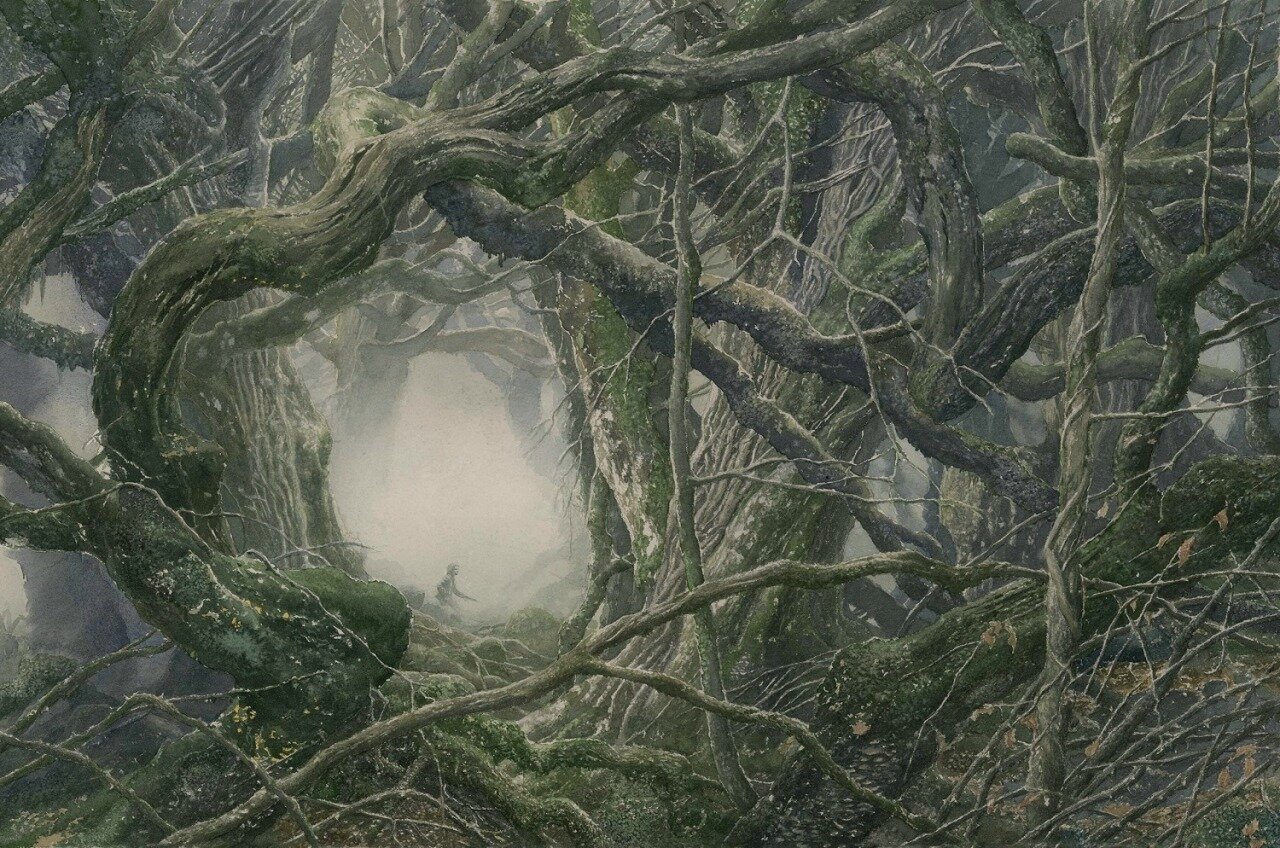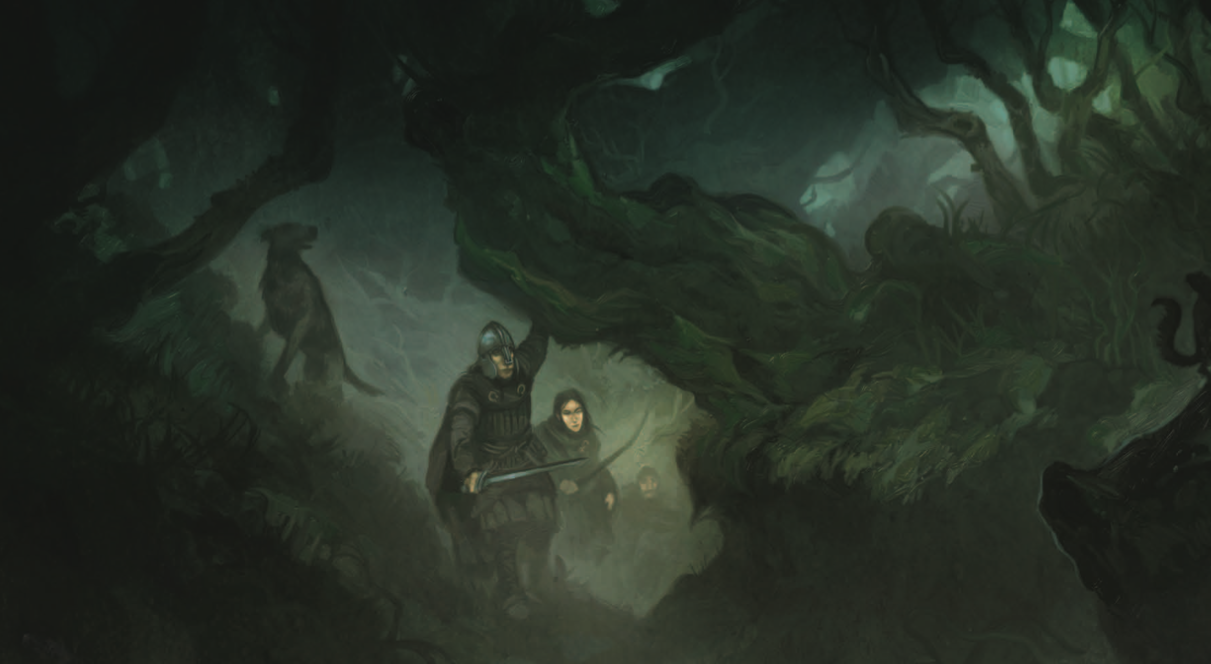Lord of the Rings Places: Mirkwood Forest
Entering Mirkwood (Credit: The One Ring RPG)
If there’s one thing that’s guaranteed to be in a fantasy story, it’s a dark, scary forest that may or may not have a candy-hoarding witch in it.
For the people living in Middle Earth, Tolkien skipped the whole witch thing (in this particular forest anyway) and went straight for something a million times worse: spiders.
But Mirkwood Forest hides more secrets than just spiders in there. In fact, Mirkwood forest wasn’t always Mirkwood.
We’re going to dive into the history of Mirkwood, the dangers inside, and what forests represent from a literary standpoint. Tolkien sure loved using their symbolism, and there’s a good reason why.
And, since our crew is running through The One Ring RPG on our actual play podcast called The Party Business Podcast, we’ll also look at how you can use Mirkwood as inspiration in your own tabletop campaign.
So, let’s stay on the path or risk getting lost in the lore of Mirkwood in The Lord of the Rings.
The (Summarized) History of Mirkwood Forest in The Lord of the Rings
Thranduil’s Halls by John Howe
Here’s the thing...if we dive into the details of the history of Middle Earth, this article is going to be tens of thousands of words long, and I’m still going to miss a ton. It’s like studying actual history, that’s how dense it is.
Ok not really, but you get it.
Let’s keep it simple.
Early on in the Lord of the Rings history books, there were a ton of forests. More accurately, I should say that they were all one big forest covering most of Middle Earth. And Middle Earth, in the early days, had more to it before a lot of the western stuff ended up at the bottom of the ocean.
BTW “western stuff” was definitely the term used by Tolkien...he was big on linguistics, after all.
Mirkwood forest was a part of this big ass forest that covered just about everything. It may have even been connected with Lothlorien at one point.
As that was cut down by Men (typical), smaller portions of it were left behind, making up the forests Lord of the Rings fans know and love. The Old Forest near the Shire, Fangorn Forest, and Mirkwood are three that definitely have the remnants of that ancient, vast tangle of woods.
Any forest with walking trees and willows that try to eat Hobbits is pretty old and has some emotional baggage from people trying to cut it all down.
But Mirkwood, at this point, was known as Greenwood the Great. Not the most clever thing the Elves ever named, that’s for sure. I’m sure there’s an Elven word for it that sounds beautiful. But it was green, and it was the woods, and it was really big: Greenwood the Great.
Great work y’all.
Now, this is before spiders and dark branches clogging up the air in the forest. Elves settled here, the Silvan Elves, which is an important distinction since, apparently, as they weren’t as cool and magical as the High Elves like Elrond and Galadriel.
I always found it funny that Tolkien makes that reference in The Hobbit. I guess these are the Duck Dynasty Elves or something. Remember that show? Didn’t think you would see a reference here, did you?
But they were still Elves, so they’re automatically better than just about everyone else. And they know it too, those cocky bastards.
Then, Sauron starts tricking everyone with these super lovely rings (I’m summarizing a couple thousand years here.) The Elves figure it out, and a whole war starts as Sauron tries to get all the rings he made back and uses his One Ring to kick everyone’s ass.
The Last Alliance of Men and Elves (that we see at the very beginning of the Fellowship of the Ring movie) defeats Sauron...kind of...and some of those Elves return to their homes, including Mirkwood.
As time goes on, Sauron starts getting his groove back and enters Greenwood the Great. He builds Dol Guldur, a fortress in “modern” Southern Mirkwood, and starts tainting Greenwood the Great. Over time the forest gets so dark and gross and spider-y that the name is changed to Mirkwood or the Forest of Great Fear.
The Forest of Great Fear isn’t exactly what you want to see on your National Park map.
The return of Sauron (known as the Necromancer at this point) brings a lot terrible things to Middle Earth, including a plague. I won’t go into details because the last thing you want to read about right now is a plague, I get that.
But Mirkwood becomes what we know it as: dark and terrible.
Also, fun fact, the spiders in Mirkwood are mostly the offspring of Shelob herself.
Sauron in Mirkwood Forest
Mirkwood Forest by J.R.R. Tolkien (yup he could draw too)
Let’s look at dates for a moment.
The Hobbit book takes place in 2941 in the timeline of Middle Earth. That means...spoiler alert, I guess, for a book you almost certainly have read because I really doubt you’re looking up Mirkwood otherwise...The Necromancer is driven out of Dol Guldur by Gandalf and the White Council “off-screen” as we follow Bilbo’s journey.
But Gandalf figured out that The Necromancer was Sauron in 2850. Bro! That’s nearly a hundred years of sitting on that information! Everyone takes forever to do anything against Sauron until, finally, Frodo leaves with the Ring. Which also takes forever for him to leave! It’s like 17ish years between Frodo leaving the Shire and Bilbo’s party.
But I digress. Just like...be more efficient, and maybe darkness has way less of a chance.
Anyway…
Sauron actually has a couple of stints as the Necromancer in Mirkwood but what’s important is the darkening of Mirkwood is directly his fault. Jerk.
Bats, spiders, and orcs make Mirkwood pretty uninhabitable. There was a very nice Dwarf road called the Old Forest Road that was unusable with the arrival of Sauron. (Orcs create abysmal traffic.)
The Elf Path that the Dwarves and Bilbo use in The Hobbit is made by the Elves and protected with their hick-elf magic, but it’s still a tough road to use. It’s so narrow, it can’t really be called a road.
Mirkwood forest gets so dark and dangerous that leaving the path is a damn foolish idea. And for a while, literally, Sauron is out there somewhere in the darkness.
What’s interesting to me is what happens after Sauron is cast out in The Hobbit. Smaug the Dragon is also dealt with, and trade flourishes again in the area for a little while. There are still, like, 78 years between The Hobbit ending and the Ring being destroyed.
That’s a lot of time for a story or two.
There are some things we know from the appendices at the end of The Return of the King. First, the darkness grows again, and Thranduil, in charge of the Mirkwood Elves and Legolas’ dad, has to fight back orcs in the forest as the Ring travels through Mordor.
At the same time, Galadriel and the Lorien Elves march to Dol Guldur and take it down.
While all that stuff is happening, Dale and the Lonely Mountain have their own battles repelling Sauron’s forces as the actual last battle in The War of the Ring. (Besides that whole Shire thing that happens in the book. Yes, I know the Battle of Bywater is the actual last battle, don’t @ me.)
Honestly, Amazon’s Lord of the Rings show should have been about all the Mirkwood and Lonely Mountain stuff, but whatever.
But for a little tiny sliver of time, there was peace but a growing worry about the return of darkness.
And that’s a story that will get told, but more on that in a sec.
Mirkwood Forest and the Literary Symbolism of the Woods
Mirkwood by Alan Lee
Forests in fairy tales and folklore are deeply rooted (get it) in our human psyche.
When humans were scraping by to survive, the forest was a double-edged sword.
On the one hand, forests provided much-needed materials. Wood, food, water sources, and shelter were just a few things our ancient ancestors needed from forests. That we honestly still need from forests.
But the darkness of the forests revealed a risk in getting those resources. There were plenty of actual dangers to worry about, but forests represented something even greater than those realistic worries: The Unknown.
The imagination is a great and terrible thing. The forest represents challenges, gifts, dangers, provisions, and a vast sea of hidden things. And if humans can't instantly understand something, they start making shit up.
The forest is the perfect setting for those things because entering the trees means leaving the known and taking a chance on something new. And new is exciting and scary at the same time.
In literature, “crossing the threshold” is a key component of the Hero's Journey. We don't really like stories that stay in the safety of the known forever and then end. Pretty boring. (Even if the cast of The Party Business Podcast laments for a pleasant stroll through the Shire constantly.)
Stories that take us into the unknown and challenge the characters are what we want to read. That means having to cross the threshold into an alien world. And the forest provides the literary playground storytellers need to force change upon their characters.
Think about Bilbo's journey in The Hobbit. It's through the trees that he has to sneak up on three trolls and begin to prove himself.
After gaining the Ring and building at least some of his confidence up, the forest is where he is left utterly alone to rescue not only himself but his companions.
And that place is none other than Mirkwood Forest itself.
The forest is a magical place–one of transformation. You go in one thing and come out another.
We still do this today. Camping is the escape from reality. Go on a hike a weary human of consumerism and anxiety, then come out the other end in tune with your roots as someone belonging to nature.
Or some crap.
And it wasn't just handed over to you–you have to earn it. You have to struggle through the hike, sweat a little, deal with your allergies, whatever the case may be. The trial of the forest might not mean facing actual spiders, wolves, and witches, but the symbolism is still there.
Tolkien, being the lover of fairy tales and mythology, did not let the importance of the transformative power of forests get away from him.
Mirkwood changes Bilbo as he saves the Dwarves from spiders.
The Old Forest reveals the dangers of the quest to Frodo, Sam, Merry, and Pippin, testing whether Frodo is willing to sacrifice himself for his friends.
Fangorn Forest forces Merry and Pippin to take a stand in the fight they have been whisked off into.
Lothlorien represents something truly ancient, magical, and possibly dangerous, even as the Fellowship gains new gifts and rest.
And I find it interesting that Mirkwood specifically goes through the change that it does. It's reduced to its boundaries in The Hobbit by greedy Men. It's cared for by the nature-loving Elves. But the Elves aren't going to be around forever. And orcs, in general, chop every tree they can find. They are the ultimate utilitarians seeing only a resource where the Elves see so much more.
Which leaves the question of what will happen to these forests when Elves leave and the orcs are all by wiped out? The race of Men are the middle ground. Will they lean more towards caring for the forests, or harvesting?
Tolkien certainly wasn't trying to say anything. Nope, not at all.
Mirkwood Forest in The Party Business Podcast
Credit: The One Ring RPG
I said earlier that I would go into more about that mysterious time in Mirkwood's history right after The Necromancer is driven out.
And I am.
Because there's a story being told about that time in our One Ring RPG actual play podcast. The Party Business Podcast sees a group of 5 companions facing the dangers of Mirkwood.
The start of our story has them crossing it, going from the east side of it to the west side—kind of like The Hobbit, but backward.
And it begins their own transformative character arcs. Some might not even come out the other side.
The ambiguous nature of Mirkwood makes for some fantastic room to play in too, as a storyteller. As the Loremaster running the game, I may have some truly crazy stuff for them to face.
It’s the freedom of the “nameless things” Tolkien talks about in The Lord of the Rings. The dark shadows of evil that can take the shape of just about anything.
Orcs and spiders? Sure. But what about great wolves infused with dark magic? Or wights that have entered the trees themselves? Or great bat creatures that drain your blood?
Fun fact: werewolves and vampires exist in The Lord of the Rings universe. Just sayin’...
But, let me be real here for a sec:
Starting an actual play podcast is kind of like going into a forest in of itself. I don't know what's going to happen in there. Are we going to be lame? Are we just a bunch of geeks that laugh at each other but others would just roll their eyes? Are we...uncool?
I mean, yes, we are, but that's because we started a One Ring RPG podcast, so nuff said.
But I'm someone that loves listening to The Adventure Zone and The Glass Cannon Podcast. I know what a good time sounds like. Can we manage that in The Party Business Podcast?
Even in Episode 1, which was a two-parter, there's something special that starts happening. The friends that joined me are hilarious and have crafted such cool Woodsmen, Beornings, Hobbits, Bardings, and Dwarves that I genuinely love listening to our own episodes.
That only gets better in Episode 2. I hate, yet love to say it–we already feel like we are hitting a stride, which means it’s only going to somehow get even better.
So if you want to see how the darkness returns to Mirkwood and what the unsung heroes of Middle Earth do about it, listen to The Party Business Podcast wherever you get your podcasts.
And if you're a geek like me, and the rest of the Party Business crew, then you probably play tabletop RPGs. That means you also probably spend a ton of time crafting characters.
Have you ever had one that just fell flat or didn't have the depth you hoped for?
We have a solution for you.
Our character creation guide is free and has simple steps to making a deep character that is a blast to play at the table no matter what game you are playing. D&D, Pathfinder, or...The One Ring RPG...these tips will help.
A lot of advice comes from crafting engaging literary characters, simplified to make it work for a character that's easy to make in a tabletop RPG.
So click here to get it emailed to you, or use the form below.






